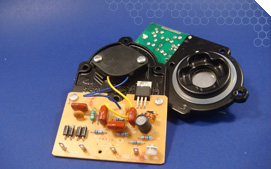Ultrasonic Nebulizers (Fluid Atomizers)
- RoHS Compliant
- economical & cost effective
- OEM electronics board and piezo element
- compact
- high mist output
- ~10,000 hour PZT ceramic lifetime
- stainless steel face
- custom environmental coatings available
- replacement assemblies and crystals available
- competitive pricing
- fast delivery
Typical Applications For Ultrasonic Nebulizers
- humidifiers / climate control
- mist / fog producers
- fountains, water statuary, indoor ponds
Install these reliable ultrasonic nebulizer boards in humidifiers, climate control systems, or decorative items.
Ultrasonic Nebulizer Boards & Component Parts
| APCI Catalog No. | Product Description | |
| 50-1011.1 | 1.65 MHz Nebulizer Board RoHs | Spec Sheet |
| 50-1013 | 1.65 MHz Replacement Assembly RoHS | Spec Sheet |
| 50-1014 | 1.65 MHz Nebulizer Crystal / Stainless Steel Face, 20mm RoHS | Spec Sheet |
Custom Design and Engineering Services
We can design nebulizers and ultrasonic transducer components for unique requirements. To discuss your specific needs, please contact an APCI representative.
Background Information
Ultrasound will effectively atomize liquids, and a stepped horn is often well suited for this application. The liquid to be dispersed is pumped into the horn, and ultrasound from the transducer radiates into the liquid. Droplets separate from the surface of the liquid and exit from the tip of the horn. Droplet size is a function of the frequency of the sound input—the droplets become smaller as the frequency increases:
Mean Diameter of Liquid Droplets = 0.73 √3 ([Surface Tension of Liquid] / ([Density of Liquid] x [Frequency of Input Signal]2 ))
In an atomization apparatus, liquid throughput increases linearly with increases in the surface area from which the liquid is radiating. A flare on the outlet end of the stepped horn effectively increases the surface area. Throughput also is a function of the amplitude of the ultrasonic vibrations, which in turn are a function of the voltage applied to the transducer. Increasing the size of the ceramic element will reduce the operating frequency, thereby increasing throughput, but at the cost of increasing the size of the droplets. Other factors limit throughput: an excessive temperature rise as a result of power dissipation in the transducer will put the ceramic element at risk for depolarization.
A second effective method for atomizing a liquid is to immerse a single ceramic disk of suitable characteristics, and approximately 1 mm thick, several centimeters below the surface of the liquid to be nebulized. Application of a voltage causes a well-chosen disk to vibrate at megahertz frequencies, and compression waves generated by this extremely high rate of vibration expel droplets from the surface of the liquid. Again, droplet size is governed by the signal frequency. A signal frequency of approximately 2 mHz will create water droplets sufficiently small to be airborne, and transducers operating at this frequency are used in air humidifiers. APC's standard nebulizer boards have been designed to work on this second apprach for atomizing liquids.
For more information on a piezoelectric nebulizers, request a quote, contact our team, or give us a call at (570) 726-6961 today.



